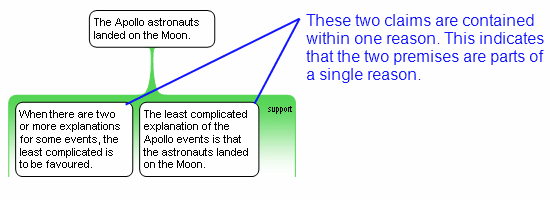
 |
|
|
|
|
| 2.2 Multiple Premises | |
Sometimes when people present reasons or objections, it is clear that they have provided two claims as part of a single complex piece of evidence. That is, they have provided more than one premise. Consider this argument:
When there are two or more explanations for some events, the least complicated is to be favoured. The least complicated explanation of the Apollo events is that the astronauts landed on the Moon. Therefore, the Apollo astronauts did in fact land on the moon. [based on 9.8-9]
In this passage, there is only one reason to believe the contention, but there are two distinct claims in that reason, i.e., two distinct premises. The two premises "work together" to support the contention.
We could map the argument this way, lumping all the premises together in one reason box.
Or we could map it by putting each premise in its own claim box. This shows much more clearly that there are two distinct claims.
| Discussion |
There are various ways to diagram arguments with multiple premises. The particular type of diagram shown above follows the approach used in the Rationale™ software. The crucial thing is that the diagram show that the premises belong together as part of one reason or objection. In the diagramming approach here, this is shown by the premises being enclosed within the one green area. You can think of the green area as an extension of the link between the premises and the contention.

| Glossary | Contents | |
|
Copyright © Critical Thinking Skills BV - |
|